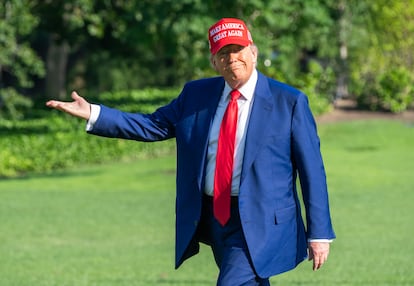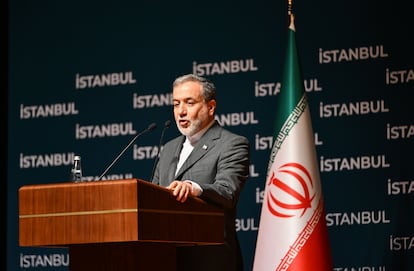Trump raises world tension with his strikes against Iran
The decision to attack by the US president, who had pledged not to drag his country into another conflict, is shaking up the Middle East and pushing the world towards a global war scenario


Washington woke up on Sunday to a few additional details about the planning that went into the strikes against three nuclear facilities in Iran the previous night, but it is still immersed in an ocean of uncertainty about what led to this unprecedented attack and, more importantly, about the unforeseeable consequences of Donald Trump’s sudden militaristic conversion. It took the U.S. president exactly five months to break his promise not to plunge his country into another conflict, and the only thing that is clear at this point is that this spectacular change of heart has triggered tensions in a Middle East that is already red hot, and on a global stage that is slipping every day a little closer to a scenario dangerously close to a global war.
Neither Secretary of Defense Pete Hegseth, who held an early morning press conference to share military details, nor Vice President J.D. Vance were able to say, beyond repeating the Trump administration’s persistent victorious rhetoric, whether the attacks had achieved their goal: to destroy the uranium enrichment capacity of the Fordo, Natanz and Isfahan bases. Hegseth reiterated the U.S. president’s message from the previous evening at the White House, where he claimed that the three facilities had been “completely and totally obliterated.” According to this unverified claim, the move is merely a deterrent to place Tehran in a dilemma between “peace” and “tragedy.” Hours later, Trump came out again to acknowledge a new goal: “It’s not politically correct to use the term, ‘Regime Change,’ but if the current Iranian Regime is unable to MAKE IRAN GREAT AGAIN, why wouldn’t there be a Regime change??? MIGA!!!” he wrote Sunday afternoon on his Truth Social network, the same platform where he had broken the news of the attack the day before.
Even before that message, the scale of the attack suggested what was really going on: on Saturday night, Trump went to war with Iran, despite Vance once again displaying his intellectual contortionism in a television interview with NBC, broadcast the following morning. The vice president, who in the past has been belligerently opposed to any military intervention abroad, said: “We’re not at war with Iran. We’re at war with Iran’s nuclear program.”
Neither Vance nor anyone in the U.S. government dared to venture what the response might be from an old enemy that has been under attack by Israel for nine days with no justification other than the claim, still unproven, that the Islamic Republic is close to obtaining the atomic bomb. U.S. intelligence services have information that contradicts this, which has not prevented Trump from joining the military campaign of Israeli Prime Minister Benjamin Netanyahu, determined to seize the opportunity to redraw the Middle East map.
Speaking from Istanbul before traveling to Moscow to meet with Vladimir Putin, Iranian Foreign Minister Abbas Araghchi invoked the “right to self-defense” and promised a response commensurate with Saturday’s attack. With Russia engaged in its own military campaign in Ukraine for nearly three and a half years, the Iranian regime finds itself in its weakest position in decades in a region that Washington analysts have dubbed “the post-October 7 Middle East,” a reference to the Hamas attack that unleashed the brutal offensive in Gaza in 2023, and which in just under two years has led to the demise of some of Tehran’s main allies in the region: from the Lebanese militia Hezbollah to the Syrian regime of Bashar al-Assad.

Strait of Hormuz
Iran is one step away from ordering the closure of the Strait of Hormuz, as recommended by its parliament on Sunday, a decision that remains subject to approval by the Supreme National Security Council. The blow would be devastating and destabilizing for the global economy: 25% of global oil demand and slightly less of gas pass through these waters, two markets that are holding their breath in anticipation of a foreseeable collapse early next week.
The regime also has the option of launching targeted attacks on U.S. interests in the region. Whether such attacks are in the immediate plans of its leader, Ayatollah Ali Khamenei, 86, was difficult to determine in the hours following Trump’s bombing. If they did occur, it is clear that tensions in the region would escalate dramatically, given the Iranian regime’s proven ability to exert influence beyond its borders. From Saudi Arabia to Qatar, several Arab countries hosting U.S. bases in an area that is home to some 40,000 U.S. troops expressed concern on Sunday about such possible retaliation.
Until those questions are cleared up, it seems clear that Trump made a phenomenal gamble on Saturday, a gamble in which his own presidency is at stake. If his calculations are correct, the American show of force — which has shattered four and a half decades of containment with Iran since the 1979 hostage crisis, which largely cost Jimmy Carter his reelection — will force Iranian envoys to sit down at the negotiating table for a nuclear deal, seven years after Trump himself pulled the United States out of the cooperation framework established through diplomatic means by his predecessor, Barack Obama.
If, on the other hand, the attack ends up being the trigger for another U.S. war abroad, along the lines of those in Iraq and Afghanistan, Trump will find himself trapped in a scenario on whose fierce opposition he built the campaign that unexpectedly brought him to the White House in 2016 against Hillary Clinton, who, as a senator, voted in 2002 to invade Iraq on the false pretext of “weapons of mass destruction.”

To ensure a second election victory, the then-candidate repeatedly promised during his campaign last year that his goal, once back in the White House, would be not only to end the existing wars (Ukraine and Gaza), but also to avoid starting new ones. He has been breaking the first promise since his inauguration in January. He dramatically broke the second one this weekend.
Internal opposition
On a domestic level, it remains to be seen how far prominent figures in the MAGA movement will go in their opposition to the war adventures their boss told them he wouldn’t pursue in order to focus on America First. Perhaps in an effort to get ahead of events, the White House press office devoted considerable effort early Sunday morning to compiling messages of support for Trump’s decision to attack Iran from a hundred Republican congressmen and 35 senators. Reading this endless email is an experience only experimental literature can provide, as well as a dizzying foray into the dynamics of the current Republican cult. And, once again, it’s important to clear up whether we’re witnessing the start of a war or not. Because if it is indeed a war, entering it would have required congressional permission, which Trump didn’t bother to seek.
As for America’s allies, the first unknown to be resolved is whether Trump will ultimately travel to the NATO summit in The Hague this week; for now, he has postponed his departure to Tuesday. European diplomats who met with Iranian representatives last Friday in Geneva received no warning of the attack on the three nuclear facilities. The leaders of the United Kingdom, France, and Germany were united in the aftermath of the bombings by a joint statement urging Iran not to respond to the U.S. escalation. Spanish Prime Minister Pedro Sánchez asserted that Saturday’s events demonstrate that “the world is beginning to peer into a dark abyss.” Antonio Guterres, Secretary-General of the United Nations, which convened its Security Council urgently to address the crisis, described the recent geopolitical dynamics as “dangerous cycle of retaliation in the Middle East.”

If the United States didn’t warn its allies, it wasn’t for lack of time: according to The Atlantic magazine (whose reporters were not accidentally included in a chat group this time, as with a previous bombing of the Houthis in an embarrassing scandal that ended up being dubbed Signalgate) the decision to drop bombs on Iran had been made as early as Wednesday. The next day, Trump said he was giving himself two weeks to resolve his concerns about a possible attack. It is now clear that this was a smokescreen to catch the enemy off guard. And here the American president played his cards well: the announcement was interpreted as further evidence of his indecision and his tendency to buy time (usually two weeks) by promising solutions that don’t always come.
According to several U.S. media reports, Trump’s mood was influenced by surprise at the “success” of Israel’s offensive against Iran launched on June 13. There is also a theory that has gained traction in Washington these days: the timing seems ripe for the regime change in Tehran the president fantasized about on Sunday in Truth.
Following the fall of Assad in Syria after decades in power, such a scenario doesn’t seem so far-fetched to the Middle East hawks nesting on the banks of the Potomac. But Iran is not Syria. And if there’s one thing everyone agrees on, hawks and doves alike, in a Washington immersed in a sea of uncertainty, it’s that it would be a mistake to underestimate a country that has been challenging the great Western empire for four and a half decades.
Sign up for our weekly newsletter to get more English-language news coverage from EL PAÍS USA Edition
Tu suscripción se está usando en otro dispositivo
¿Quieres añadir otro usuario a tu suscripción?
Si continúas leyendo en este dispositivo, no se podrá leer en el otro.
FlechaTu suscripción se está usando en otro dispositivo y solo puedes acceder a EL PAÍS desde un dispositivo a la vez.
Si quieres compartir tu cuenta, cambia tu suscripción a la modalidad Premium, así podrás añadir otro usuario. Cada uno accederá con su propia cuenta de email, lo que os permitirá personalizar vuestra experiencia en EL PAÍS.
¿Tienes una suscripción de empresa? Accede aquí para contratar más cuentas.
En el caso de no saber quién está usando tu cuenta, te recomendamos cambiar tu contraseña aquí.
Si decides continuar compartiendo tu cuenta, este mensaje se mostrará en tu dispositivo y en el de la otra persona que está usando tu cuenta de forma indefinida, afectando a tu experiencia de lectura. Puedes consultar aquí los términos y condiciones de la suscripción digital.










































